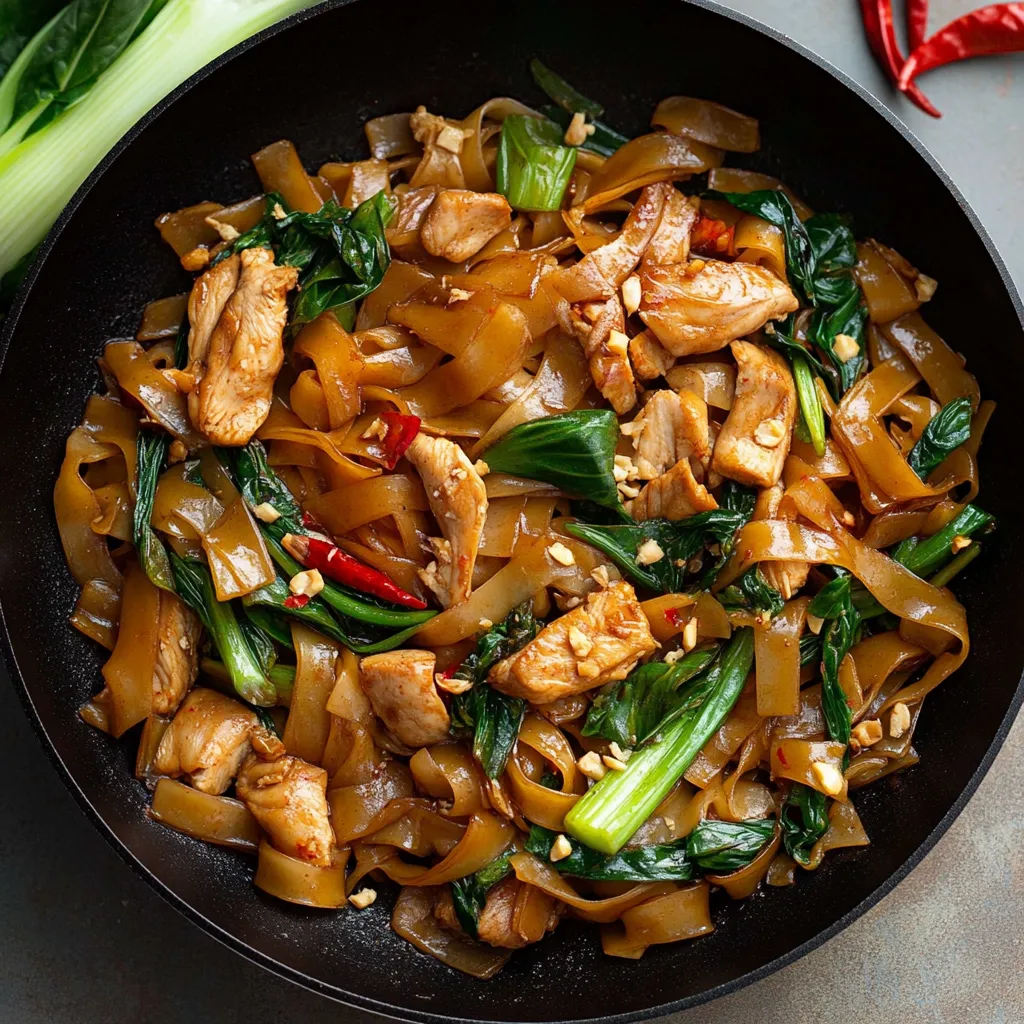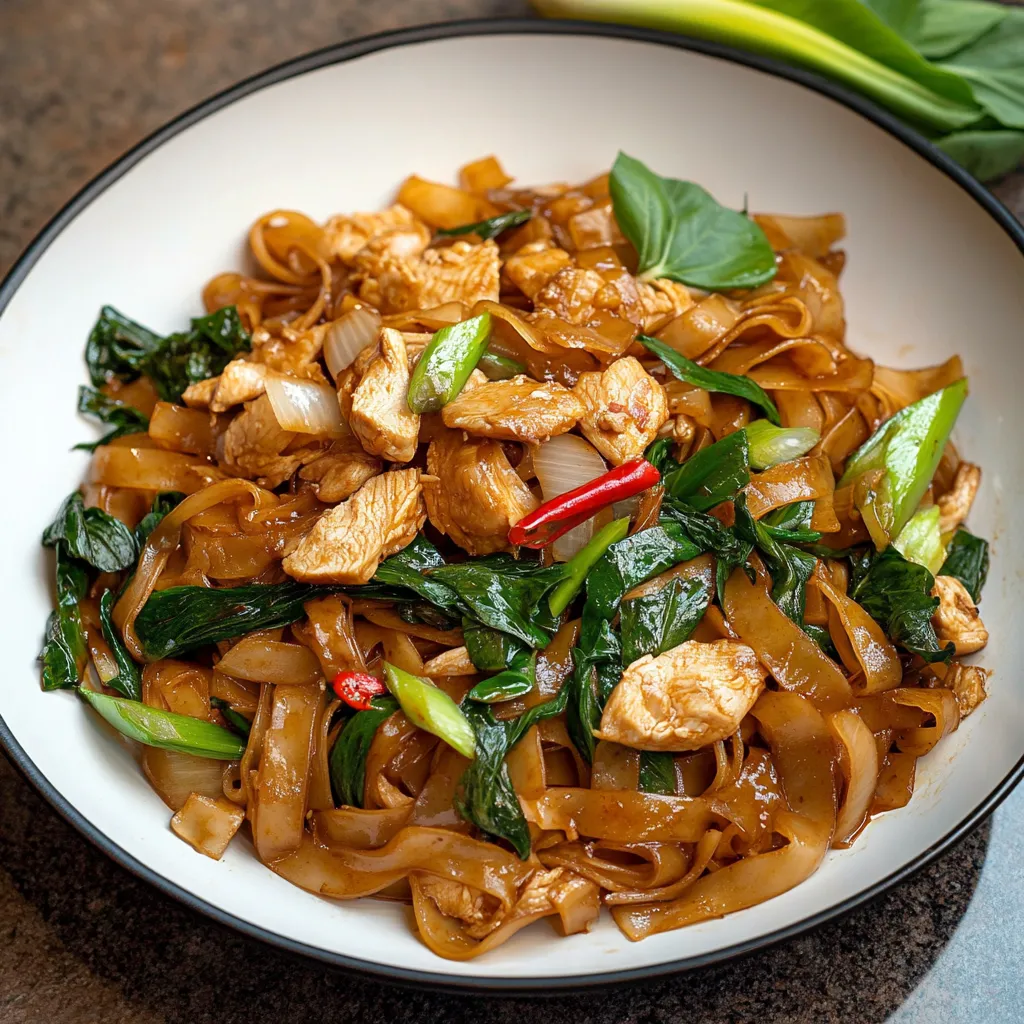 Pin it
Pin it
This authentic Drunken Noodles recipe brings the vibrant flavors of Thai street food right to your kitchen. The combination of wide rice noodles, tender chicken, and aromatic herbs creates a dish that balances sweet, savory, and spicy notes perfectly. I discovered this recipe during my travels through Thailand and have spent years perfecting it to capture that authentic street food essence.
I first made these Drunken Noodles after returning from a street food tour in Bangkok. The combination of charred noodles with fresh basil instantly transported me back to those bustling night markets. Now it has become our Friday night tradition when we crave something quick but impressive.
Ingredients
- Rice noodles: Medium wide variety provides the perfect chewy texture that absorbs all the wonderful sauce
- Chicken thighs: Juicier than breast meat and stays tender even with high heat cooking
- Holy basil: The authentic choice with its distinctive peppery flavor unlike regular basil
- Thai red chili peppers: Adjust quantity based on your heat tolerance
- Baby bok choy: Adds freshness and slight crunch to balance the richness
- Soy sauce: Creates the umami base flavor
- Dark soy sauce: Provides color and deeper flavor
- Oyster sauce: Adds that characteristic sweet richness to authentic Thai dishes
- Fish sauce: The essential ingredient that gives the dish its authentic Thai flavor profile
- Brown sugar: Balances the saltiness from the sauces
Step-by-Step Instructions
- Prep the Protein:
- Cut chicken against the grain into thin strips about ¼ inch thick. Marinate with soy sauce for 15-20 minutes. This quick marinade tenderizes the meat while you prepare other ingredients. Cutting against the grain ensures each bite remains tender rather than chewy.
- Prepare the Noodles:
- Soak dried rice noodles according to package instructions. I prefer using hot water rather than boiling to prevent overcooking. They should be pliable but still slightly firm as they will cook further in the wok. Drain thoroughly to prevent a soggy final dish.
- Make the Sauce:
- Combine all sauce ingredients in a small bowl until sugar dissolves completely. This balanced sauce is the heart of the dish with the perfect ratio of savory to sweet. Taste and adjust if needed. Having the sauce ready ensures quick cooking once you start the stir fry process.
- Cook the Chicken:
- Heat your wok until smoking hot before adding oil. Sear chicken in batches if necessary to prevent overcrowding which would steam rather than sear the meat. The high heat creates those delicious charred edges that are characteristic of street food. Remove and set aside when 90% cooked.
- Build the Flavors:
- Sauté aromatics briefly until fragrant but not browned. The onions and garlic create the aromatic base while the chilies infuse the oil with spiciness. Keep everything moving in the wok to prevent burning. This quick cooking preserves the fresh flavors.
- Combine and Finish:
- Add vegetables and cook just until they begin to soften. Return chicken to the wok along with drained noodles. Pour sauce around the edges where it will sizzle and create that characteristic wok hei flavor. Toss continuously over high heat for about 2 minutes until noodles char slightly and absorb the sauce.
 Pin it
Pin it
My favorite part of making this dish is the moment when the basil hits the hot wok and releases its incredible aroma throughout the kitchen. It reminds me of watching street vendors in Thailand expertly tossing enormous woks of noodles over roaring flames.
The Secret to Wok Hei
The distinctive smoky flavor in authentic Thai noodle dishes comes from what Chinese cooks call wok hei or breath of the wok. To achieve this at home, ensure your wok is extremely hot before adding ingredients. Allow the noodles to sit undisturbed for 20-30 seconds at a time to develop slight charring before tossing. This technique creates those delicious caramelized spots that make restaurant quality noodles so addictive. Home stoves typically cannot reach the high temperatures of commercial wok burners, so allowing for this extra contact time compensates for the temperature difference.
Make It Your Own
This recipe is incredibly versatile and forgiving. For a vegetarian version, substitute the chicken with firm tofu or increase the vegetables. Mushrooms like shiitake or oyster varieties add wonderful umami flavor. For those avoiding fish sauce, try coconut aminos with a splash of lime juice for a similar depth. The traditional recipe calls for holy basil, but Thai basil or even regular basil can work in a pinch. The key is maintaining the balance between sweet, savory, spicy and herbaceous flavors that make Thai cuisine so beloved.
Proper Noodle Selection
The type of noodle significantly impacts the final dish. Traditional drunken noodles use fresh wide rice noodles called sen yai, but dried rice stick noodles make a good substitute. The wider the noodle, the better it absorbs the flavorful sauce. When preparing dried noodles, slightly undercook them as they will continue softening in the wok. If using fresh noodles, separate them carefully and briefly rinse under warm water if they are stuck together. Fresh noodles require less cooking time and will quickly take on the smoky wok flavor.
 Pin it
Pin it
Enjoy creating this taste of Thailand in your own kitchen with these authentic Drunken Noodles!
Frequently Asked Questions
- → Why are they called Drunken Noodles?
Despite the name, this dish contains no alcohol. The name 'Drunken Noodles' is believed to come from either how they're perfect for eating after a night of drinking due to their spicy flavor profile, or because the dish is so spicy it makes you feel drunk. Some say it's also because you might stagger like a drunk person after eating something so spicy!
- → Can I substitute the holy basil?
Holy basil (Thai basil) gives authentic flavor, but if unavailable, you can substitute with regular sweet basil. The flavor will be slightly different, as holy basil has a more peppery, clove-like taste compared to sweet basil's milder flavor. In a pinch, a mix of regular basil with a small amount of mint can approximate the complexity.
- → How spicy are Drunken Noodles?
Traditional Drunken Noodles are meant to be quite spicy with Thai bird's eye chilies. However, you can easily adjust the heat level by reducing or increasing the number of chilies. For a milder version, remove the seeds from the chilies or substitute with bell peppers for color without heat.
- → What protein options work best?
While this recipe uses chicken, Drunken Noodles are versatile and work well with many proteins. Try shrimp for a quick-cooking seafood option, thinly sliced beef for a heartier dish, tofu for a vegetarian version, or a combination. Adjust cooking times accordingly as seafood and thinly sliced beef cook faster than chicken.
- → Can I make this dish ahead of time?
Drunken Noodles are best enjoyed fresh off the wok when the noodles have the perfect texture. If you need to prepare components ahead, you can mix the sauce, slice the meat, and prepare the vegetables in advance. Store separately in the refrigerator. Rice noodles tend to harden when refrigerated, so cook the dish completely just before serving for optimal results.
- → What's the difference between Pad Thai and Drunken Noodles?
While both are popular Thai noodle dishes, Pad Thai uses thinner rice noodles and has a tangy, sweet sauce with tamarind paste, lime, and palm sugar. Drunken Noodles feature wider rice noodles and a savory, spicy sauce with soy sauce, fish sauce, and oyster sauce. Pad Thai often includes peanuts and bean sprouts, while Drunken Noodles highlight basil and typically pack more heat.
